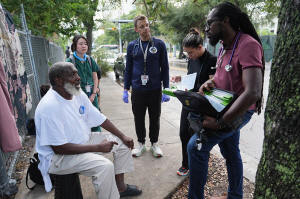How a Miami health care group is meeting homeless patients where they
live
[October 04, 2025]
By DAVID FISCHER
MIAMI (AP) — Jonas Richards became homeless several years ago after
losing his job as a truck driver. Despite suffering from high blood
pressure and diabetes, seeing a doctor hasn't been a major priority
since then.
“When you're homeless, it's not easy,” Richards said. “You find yourself
hustling, trying to keep a little money in your pocket, trying to find
something to eat.”
But Richards recently had his first visit with doctors from Miami Street
Medicine while sitting on a curb outside a homeless shelter.
“You get everything done right here very fast,” Richards said. “It was a
big help.”
Miami Street Medicine is a nonprofit organization providing free mobile
health care services to homeless people. It’s part of a larger group,
Dade County Street Response, which also includes a free clinic called
Doctors Within Borders, a disaster relief team and a mental health
crisis line.
Building trust with care
Miami Street Medicine teams of paid staff and medical school student
volunteers aren’t just bandaging cuts and handing out aspirin. They’re
performing intake on patients with tablet computers and offer follow-up
visits for chronic conditions. They're working with specialists like
dermatologists, neurologists and cardiologists.

“We’re out there to meet the needs of our patients,” founder Dr. Dan
Bergholz said. “And if that’s a cough drop, we’ve got you. We are happy
to help you with that cough drop. But really the mission is so much
greater. It’s showing that we care, and we’re there for them. So when
that cough becomes pneumonia, they’ll let us listen to their lungs and
maybe trust us to take them to the hospital.”
Bergholz began laying groundwork for Miami Street Medicine about seven
years ago. He said he had started doing charity outreach with homeless
people as an undergraduate, but it seemed like more could be done.
“It just felt like we weren’t quite moving the needle for folks,”
Bergholz said.
After learning more about the growing trend of street medicine and being
accepted to the University of Miami’s medical school, Bergholz began
working with other students to set up a program.
“I moved down to Miami early and just started hitting the streets and
chatting with people,” he said. “You could call it a needs assessment.”
Just as Miami Street Medicine was taking off, the COVID-19 pandemic hit
and forced the group to adjust. Bergholz connected with Dade County
Street Response to provide health care to more underserved areas.
“A sort of bigger vision emerged to fill the gaps in the local social
safety net,” Bergholz said.
Regular treatment
One challenge is the transient nature of homeless people, which makes it
difficult to provide continual care. Dr. Armen Henderson, founder of
Dade County Street Response, said the problem is compounded by laws that
target homeless people.
to top of second column]
|

Dr. Inaki Bent, right, talks with Jonas Richards, left, while
working with the Miami Street Medicine team to provide medical
services to homeless people, Saturday, Aug. 23, 2025, in Miami. (AP
Photo/Lynne Sladky)
 “The criminalization of homelessness
has significantly impacted our patients’ ability to be in one place
to get services,” Henderson said. “For the street medicine team,
they know they meet us in one place. But if the majority of those
patients are now ending up in jail, now the people are trying to
figure out what places are police not harassing them.”
Another challenge is fighting the common sentiment that providing
services actually increases homelessness, Henderson said.
“The only thing that ends homelessness is easy access to housing,”
he said. “There’s nothing that encourages people to be unsheltered.
No one wants to be unsheltered. So by offering services like this,
we’re actually trying to ease people’s suffering. When people come
in here, they want to get off the street. They want to figure out a
plan.”
An ounce of prevention
Members of Miami Street Medicine have noticed more people losing
their homes in recent years as prices increase and wages remain
stagnant. Dr. Inaki Bent, who oversees street medicine teams, said
he’s also seen an increase in undocumented migrants on the streets
as the state and federal governments have expanded immigration
enforcement this year.
“I see patients here who are no longer working,” Bent said. “They’re
no longer working because the fields and the construction sites have
become targets. And they would prefer not to be employed or not to
expose themselves to that risk.”

In addition to the individual benefit to patients, providing medical
treatment on the street and at the group's clinic prevents treatable
conditions from becoming emergencies that ultimately strain the
entire health care system. For example, Bent had a patient who had
previously been treated for seizures at an emergency room and
received a prescription, but couldn't afford it. The patient would
have eventually ended up back in the ER, but Miami Street Medicine
paid for his medicine.
“So we’re able to fill that void and hopefully prevent a couple more
admissions,” Bent said. “But we're also able to do a human service
for him, for our fellow man, to provide him with the necessary
health care so he can begin his path toward a productive life.”
All contents © copyright 2025 Associated Press. All rights reserved |